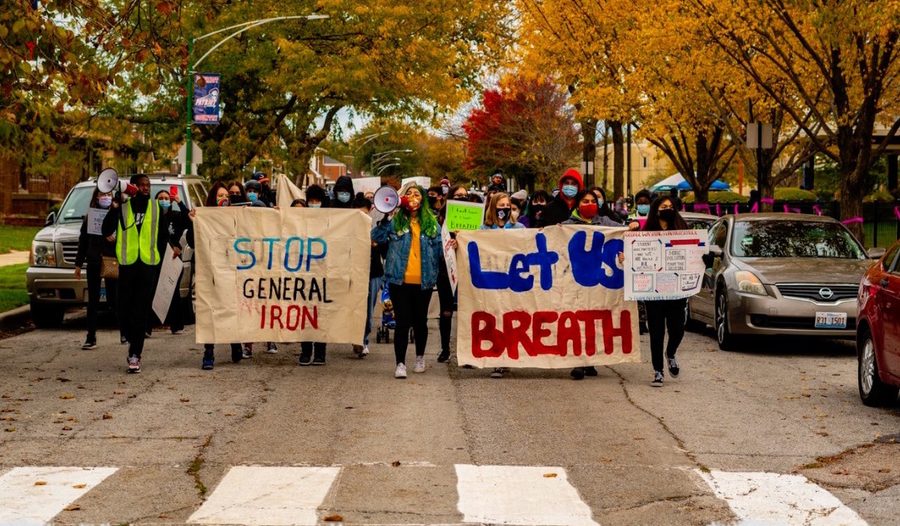“Solidarity Is How We Win”: After Years of Fighting Toxic Scrapyard, Activists Celebrate a Victory in Chicago
By protesting and going out on hunger strike, environmental justice advocates helped stop a controversial metal scrapper from being built on Chicago’s Southeast Side.
Keisa Reynolds

A recent victory for Chicago’s environmental justice movement demonstrated the power of multiracial, multigenerational organizing, and solidarity across impacted communities. On February 18, Chicago’s Health Department denied the final permit that would have allowed a metal scrapper to open a controversial facility on the city’s Southeast Side, a predominantly Black and Latinx neighborhood.
In 2018, General Iron announced that it would partner with Reserve Management Group (RMG) and open a facility, known as Southside Recycling, near a public elementary school and high school in Chicago’s 10th Ward. Former Mayor Rahm Emanuel made a backdoor agreement with General Iron and its parent company RMG to relocate from the wealthy North Side neighborhood of Lincoln Park to the Southeast Side, with plans finalized in 2019. RMG owned land on the Southeast Side and agreed to move as long as permits would be approved.
Over three years, opposition grew among 10th Ward residents and environmental justice advocates who formed the Stop General Iron Campaign and filed federal civil rights complaints, led protests and carried out direct actions against the pending permit.
In February 2021, organizers and allies participated in a month-long hunger strike to oppose the facility, which they charged would spew pollution to nearby residents. Soon after the strike ended, the permit was put on hold pending an environmental study at the request of Michael Regan, the head of the U.S. Environmental Protection Agency (EPA).
The Stop General Iron Campaign has been led by a coalition of organizations including Southeast Environmental Task Force, Alliance of the Southeast, Southeast Youth Alliance, the Student Voice Committee at George Washington High School and many others.
In These Times spoke with Lauren Bianchi, who serves on the campaign’s steering committee. A Chicago Public Schools social studies teacher, Bianchi joined the campaign two years ago as many of her colleagues and students became involved in the fight.
After years of organizing, the Stop General Iron Campaign won when the permit was denied in February 2022. Can you share how the campaign led to this victory?
General Iron had already incurred many fines and had a record of fires, noise and smell complaints in Lincoln Park. This is a company [where] residents should have the opportunity to understand what was being proposed. They shut down the Lincoln Park location and they started construction on this site in the 10th Ward while they waited for the permit to be approved.
A very determined group of people who lived and worked in the 10th Ward, said, “No, we will not accept another polluter in a neighborhood that already faces a very high cumulative impact of the existing heavy industry. We don’t care that this would be a high-tech, state-of-the-art facility because why would we accept any additional pollution?”
The permit was going to allow this company to produce additional particulate matter each year. There were protests, which escalated to a hunger strike, when the city drew out the process and was not letting us know that the permit would be denied.
After the hunger strike, we got our first major victory. The city did not respond to our demands during the course of the hunger strike. People did not eat solid food for 30 days, and the city did not say anything in response. At 30 days, we made the decision that people’s lives were at risk and we had to end the hunger strike. Two months later, Biden’s head of the EPA, Michael Regan, steps in.
That was the first major victory because it meant that as long as that health assessment was happening, the permit could not be issued. And the fact that the federal government got involved was huge. It should not have taken a hunger strike to get to that point, but it was a huge victory.
[The assessment] was a very drawn out, exhausting process where there were multiple community meetings that were led by the city and weren’t necessarily engaging with the community members again. It was very much the city coming in and doing the process without working in partnership with community leaders and residents, but saying, “We want to hear from residents, we value residents’ voices,” — trying to make it seem like they did.
After the third health assessment meeting, that Friday in February, is when we got the decision that the permit had been denied.
What kind of support did the campaign receive from the public?
Chicago has multiple environmental justice communities that are in different parts of the city. The East Side environmental activists that led this campaign got an enormous amount of support from people fighting against Hilco in Little Village, people fighting against MAT Asphalt in McKinley Park. There’s a group called Neighbors for Environmental Justice (N4EJ). And there’s Byron Sigcho-Lopez, an aldermen in Pilsen — another environmental justice community that deals with their own problem of metal scrappers and other industrial facilities. He [Sigcho-Lopez] actually joined the hunger strike as did another activist from Pilsen.
We’ve had people from Pilsen, Little Village, McKinley Park become leaders in this campaign to say, “We stand with the 10th Ward. You need to deny the permit.”
This fight was always about more than one permit. This fight was always about asking, “Why are our residents across the city always having to fight against these individual companies that are causing environmental issues?” We need some kind of air ordinance or citywide protections that are going to ensure that people don’t have to spend years of their lives fighting all of these individual issues when they are all part of the systemic lack of protections for clean air, water, and soil for residents.
The permit was put on hold in May 2021, which was a win itself. How did the campaign keep its momentum after that?
This campaign definitely had its ups and downs. The height of the campaign was during the hunger strike. We were having up to four Zoom meetings a week, constantly organizing, constantly checking in on the hunger strikers, constantly doing media outreach. There was a lot of social media support from people across the country.
In terms of keeping up the momentum, that was a huge challenge because the timeline was never totally clear to us. We had to continually evaluate: When is a decision going to be made? Do we think the decision will be in our favor, or in favor of the company? What strategy do we use now? How do we keep people in this city engaged in this fight?
At various points, we kept the momentum up by keeping in touch with each other, building relationships with each other. The campaign had retreats where we could talk about strategy, socialize, and eat food together. We basically had weekly meetings for the last two years straight. The campaign, at least at the point when I got involved, we constantly had that space where we were touching base, sharing updates. Not everybody, maybe some people will take time away to rest, but whoever is available is going to meet on a regular basis to keep the momentum going.
General Iron was forced to move out of Lincoln Park and permitted to open on the Southeast Side. Can you speak to whether environmental racism played a role in the decision to open a facility on the Southeast Side?
I am a social studies teacher, and I am often struggling to get my students to understand that racism is not just bad people who are mean. Racism is systemic, it is embedded in laws and policies. Is the case that this is just an evil company that chose to move into a majority Latinx and Black community? Absolutely not, but our city’s zoning policies are rooted in redlining and historical segregation. Some of the only areas that are zoned to allow for heavy industry are in communities of color.
It just so happened to be that RMG — which had a facility in the Southeast Side — purchased the company, so it made sense for them to expand one of their existing facilities as a replacement. But it is not an accident that the 10th Ward is one of the only areas that is zoned in such a way that you can move these types of things to that neighborhood.
We have to understand that environmental racism is part of systemic racism and the legacy of segregation in Chicago.
How does this campaign connect to the larger movement against environmental racism and corporate power?
I am a newcomer to the environmental justice movement. I learned a ton in the last two years. I had not personally gotten very involved with the climate justice movement, or specifically environmental related work before. I had no choice because my workplace became embroiled in this. But I think that we have very little time to try to avoid some of the worst impacts of the ongoing climate crisis.
It is really urgent for environmental justice communities in the United States and around the world to have the opportunity to lead the way. Frontline communities have been fighting back and have been the leaders making the connections between corporate power and control of land, and blowing the whistle on the fact that so many people living in the United States do not have clean drinking water [and] have to endure air quality at higher rates of asthma and other diseases.
When we went to City Hall after the permit was denied, one of our campaign leaders, Olga Bautista from Southeast Environmental Task Force, had a message: Every environmental justice community from Flint to Chicago and beyond, we stand with you. You actually can win. If we build these movements to be multiracial, multigenerational — and include parents and young people and workers who live in the communities and people who are most affected — we actually can win if we fight back.
All these struggles are connected. We need to be talking to each other, we need to be learning from each other. And we do need to build alliances between all of these environmental struggles, because ultimately this is very much connected to the movement for climate justice. We need an economic system that is not going to destroy our air and water. We don’t currently have that. This society too often puts profits over people.
Do you think this campaign could serve as a model for others?
We had a lot of lessons to learn in this campaign, it’s not like we didn’t make mistakes along the way. Some of the lessons that I think are valuable: the need to learn from our community elders who have been fighting this struggle a long time, but also let young people lead at various points.
When students and young people who live in the neighborhood got involved and started saying, “I’m an athlete and I need to be able to breathe to play my sport,” and “We can’t learn if we can’t breathe.” That was really powerful because in this society we are supposed to value the health and wellbeing of young people.
It really comes down to the meaning of solidarity. Getting people to make those connections that actually affect all of us who live and work in the neighborhood. Solidarity is how we win. We have to make the argument to people that you might think that this doesn’t affect you, but, as one of the hunger strikers, Yesenia Chavez, said: All of Chicago is polluted. Some of Chicago is a lot more polluted than others, but this affects everyone in the area. There’s no borders around pollution.
What’s next for the campaign?
The Chicago Teachers Union is getting ready to launch a campaign for green school buildings. There are schools in Chicago that have asbestos tile, have tested positive for lead, and have issues with flooding and mold. This is a really important opportunity to say that these are workplace hazards for the teachers and staff, hazards for the children, and they are also environmental hazards. Educational justice is environmental justice. That is a next step that I am hoping teachers and parents will be engaging with going forward.
In terms of the environmental justice movement in Chicago, I think that activists have been very clear that we need citywide policies and ordinances to be passed through city council that will make it so that these companies that are consistently being fined for violating EPA guidelines aren’t just getting a slap on the wrist. We need an enforceable benchmark that forces these companies to operate safely. We can’t have the heaviest industry in residential areas surrounded by schools and homes where people live.
Keisa Reynolds, who is on the In These Times board of directors, is also a freelance writer.







